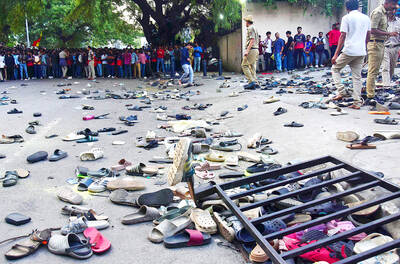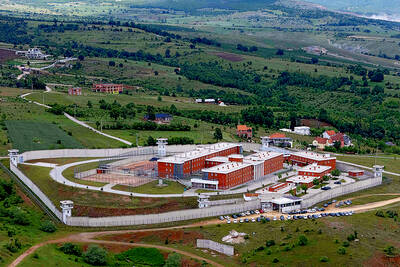As dawn broke in central Kenya, a helicopter lifted off in a race to find roosting locusts before the sun warmed their bodies and sent them on a ravenous flight through farmland.
Pilot Kieran Allen began his painstaking survey from zebra-filled plains and lush maize farms, to dramatic forested valleys and the vast arid expanses further north, his eyes scouring the landscape for signs of the massed insects.
The chopper suddenly swung around after a call came in from the locust war room on the ground: a community in the foothills of Mount Kenya has reported a swarm.

Photo: AFP
“I am seeing some pink in the trees,” his voice crackled over the headphones, pointing to a roughly 30-hectare swathe of desert locusts.
Reddish-pink in their immature — and hungriest — phase, the insects smothered the tips of a pine forest.
Allen determined that nearby farms were at a safe distance and called in a second aircraft, which arrived in minutes to spray the swarm with pesticide.
On the ground, having warmed to just the right temperature, the thick cloud of locusts filled the air with a rustling akin to light rainfall.
However, in a few hours, many would be dead from the effect of the poison.
Last month alone, Allen logged almost 25,000km of flight — more than half the circumference of the world — in his hunt for locusts after a fresh wave of insects invaded Kenya from Somalia and Ethiopia.
Like other pilots involved in the operation — who have switched from their usual business of firefighting, tourism, or rescuing hikers in distress — he has become an expert on locusts and the dangers they pose.
“Those wheat fields feed a lot of the country. It would be a disaster if they got in there,” he said, pointing to a vast farm in a particularly fertile area of Mount Kenya.
Desert locusts are a part of the grasshopper family that form massive swarms when breeding is spurred by good rains.
They are notoriously difficult to control, for they move up to 150km daily. Each locust eats its weight in vegetation daily and multiplies 20-fold every three months.
The locusts first infested the east and Horn of Africa in the middle of 2019, eventually invading nine countries as the region experienced one of its wettest rainy seasons in decades.
Some countries like Kenya had not seen the pest in up to 70 years and the initial response was hampered by poor coordination, lack of pesticides and aircraft, said Cyril Ferrand, a Nairobi-based expert with the UN’s Food and Agriculture Organization (FAO).
A slick new operation to combat a second wave of the pests has improved control and cooperation in Kenya, Ethiopia and parts of Somalia.
In Kenya, the FAO has teamed up with the company 51 Degrees, which specializes in managing protected areas.
It has rejigged software developed for tracking poaching, injured wildlife and illegal logging and other conservation needs to instead trace and tackle locust swarms.
A hotline takes calls from village chiefs or some of the 3,000 trained scouts, and aircraft are dispatched.
Data on the size of the swarms and direction of travel are shared with the pilots as well as governments and organizations battling the invasion in Somalia, Kenya and Ethiopia.
“Our approach has completely been changed by good data, by timely data, and by accurate data,” 51 Degrees director Batian Craig said.
The operation in Kenya had focused on a “first line of defense” in remote and sometimes hostile border areas, which had successfully broken up massive swarms coming in from Ethiopia and Somalia before they reach farmland further south, he said.
In a complex relay, when the wind shifts and the swarms head back into Ethiopia, pilots waiting on the other side of the border take over the operation.
Southern and central Somalia is a no-go zone due to the presence of al-Shabaab militants and the teams can only wait for the swarms to cross over.
Ferrand told reporters that last year the infestation affected the food supply and livelihoods of about 2.5 million people, and was expected to affect 3.5 million this year.
While a forecast of below-average rainfall and the improved control operation could help curb the infestation, it was difficult to say when it would end, he said.

Packed crowds in India celebrating their cricket team’s victory ended in a deadly stampede on Wednesday, with 11 mainly young fans crushed to death, the local state’s chief minister said. Joyous cricket fans had come out to celebrate and welcome home their heroes, Royal Challengers Bengaluru, after they beat Punjab Kings in a roller-coaster Indian Premier League (IPL) cricket final on Tuesday night. However, the euphoria of the vast crowds in the southern tech city of Bengaluru ended in disaster, with Indian Prime Minister Narendra calling it “absolutely heartrending.” Karnataka Chief Minister Siddaramaiah said most of the deceased are young, with 11 dead

By 2027, Denmark would relocate its foreign convicts to a prison in Kosovo under a 200-million-euro (US$228.6 million) agreement that has raised concerns among non-governmental organizations (NGOs) and residents, but which could serve as a model for the rest of the EU. The agreement, reached in 2022 and ratified by Kosovar lawmakers last year, provides for the reception of up to 300 foreign prisoners sentenced in Denmark. They must not have been convicted of terrorism or war crimes, or have a mental condition or terminal disease. Once their sentence is completed in Kosovan, they would be deported to their home country. In

Brazil, the world’s largest Roman Catholic country, saw its Catholic population decline further in 2022, while evangelical Christians and those with no religion continued to rise, census data released on Friday by the Brazilian Institute of Geography and Statistics (IBGE) showed. The census indicated that Brazil had 100.2 million Roman Catholics in 2022, accounting for 56.7 percent of the population, down from 65.1 percent or 105.4 million recorded in the 2010 census. Meanwhile, the share of evangelical Christians rose to 26.9 percent last year, up from 21.6 percent in 2010, adding 12 million followers to reach 47.4 million — the highest figure

LOST CONTACT: The mission carried payloads from Japan, the US and Taiwan’s National Central University, including a deep space radiation probe, ispace said Japanese company ispace said its uncrewed moon lander likely crashed onto the moon’s surface during its lunar touchdown attempt yesterday, marking another failure two years after its unsuccessful inaugural mission. Tokyo-based ispace had hoped to join US firms Intuitive Machines and Firefly Aerospace as companies that have accomplished commercial landings amid a global race for the moon, which includes state-run missions from China and India. A successful mission would have made ispace the first company outside the US to achieve a moon landing. Resilience, ispace’s second lunar lander, could not decelerate fast enough as it approached the moon, and the company has